Filipino Chicken Adobo
- By Jennifer Segal
- Updated September 12, 2025
- 147 Comments
- Leave a Review

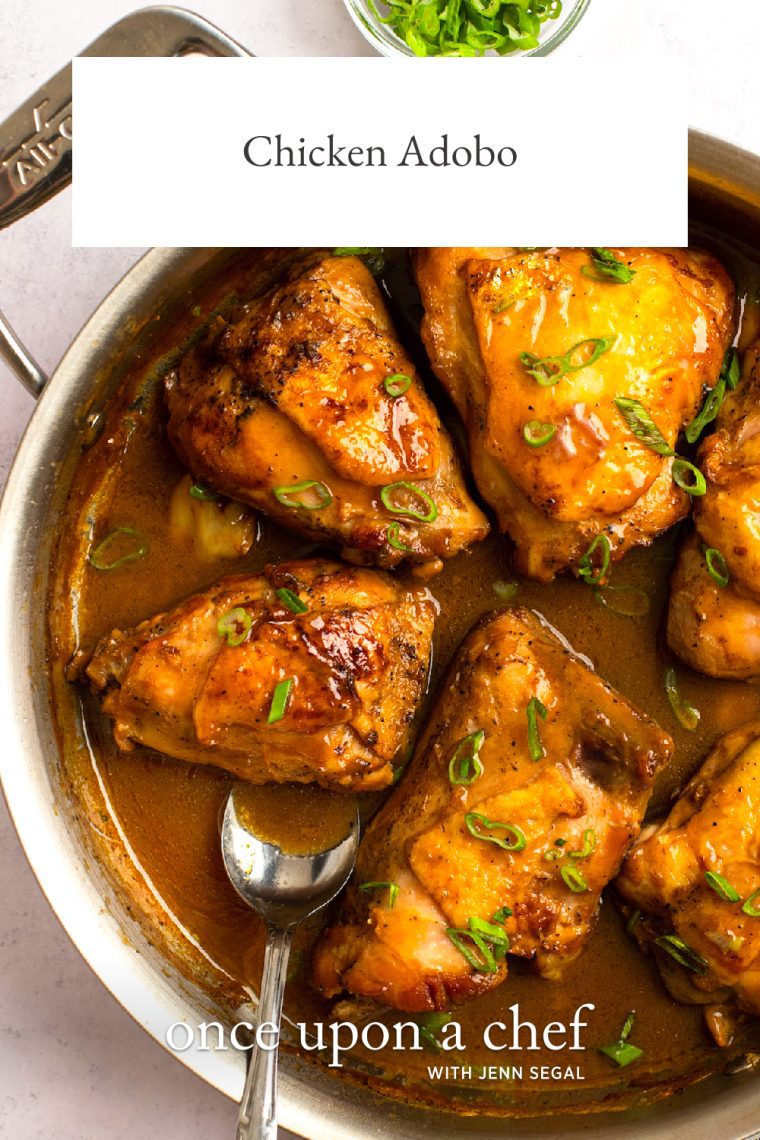
This post may contain affiliate links. Read my full disclosure policy.
An iconic Filipino dish, this chicken adobo recipe features succulent chicken simmered in a bright vinegar-soy sauce enriched with creamy coconut milk. It’s tangy, savory, and deeply comforting—the kind of craveable dinner your family will ask for again and again.
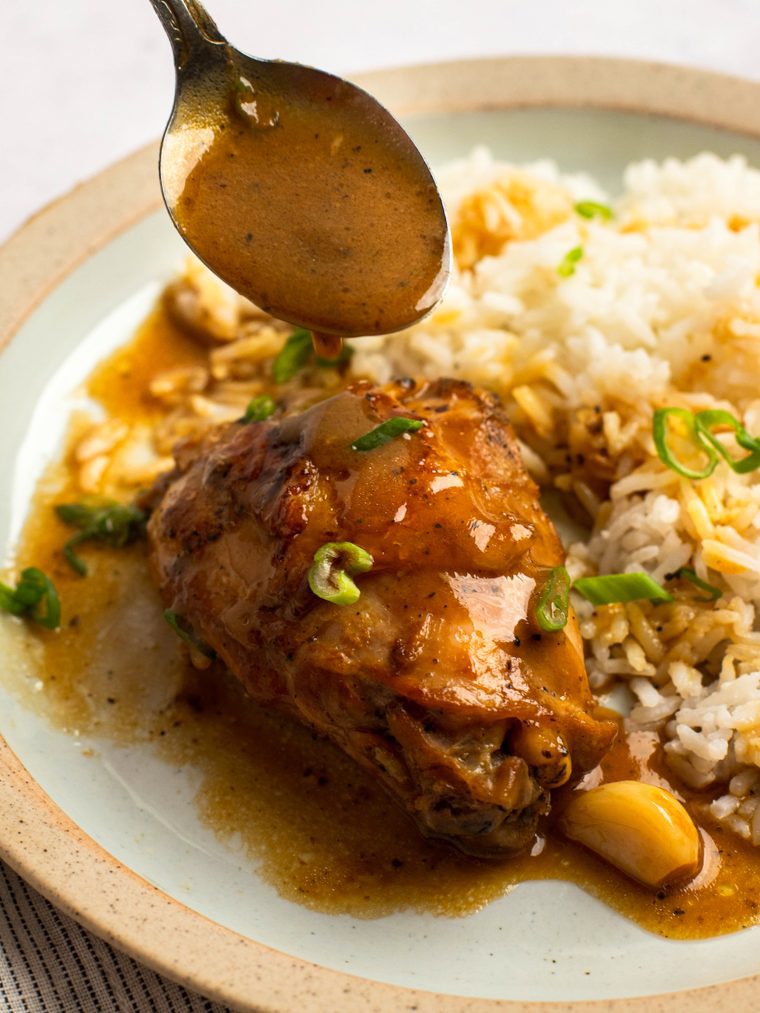
Adobo is a beloved dish in the Philippines that involves simmering meat in a tangy sauce made with vinegar, soy sauce, garlic, bay leaves, and black pepper. There are many ways to make adobo, but my personal favorite is a regional variation made with chicken and coconut milk, inspired by Filipino Chef Romy Dorotan from the now-closed Purple Yam in Brooklyn. The addition of coconut milk helps to temper the tanginess of the vinegar while adding a velvety texture to the sauce. The dish remains tangy, but the flavors are all in harmony, making it a delicious and satisfying meal.
To enjoy chicken adobo at its best, serve it over a bed of fragrant jasmine rice to soak up the luscious sauce, and add a vegetable, such as roasted carrots or roasted asparagus, to complete the dish. Whether you’re a fan of Filipino cuisine or just looking for a new and exciting recipe to try, chicken adobo is sure to impress!
“This dish was absolutely amazing. Such wonderful flavor and the recipe was so easy to follow.”
What You’ll Need To Make Chicken Adobo
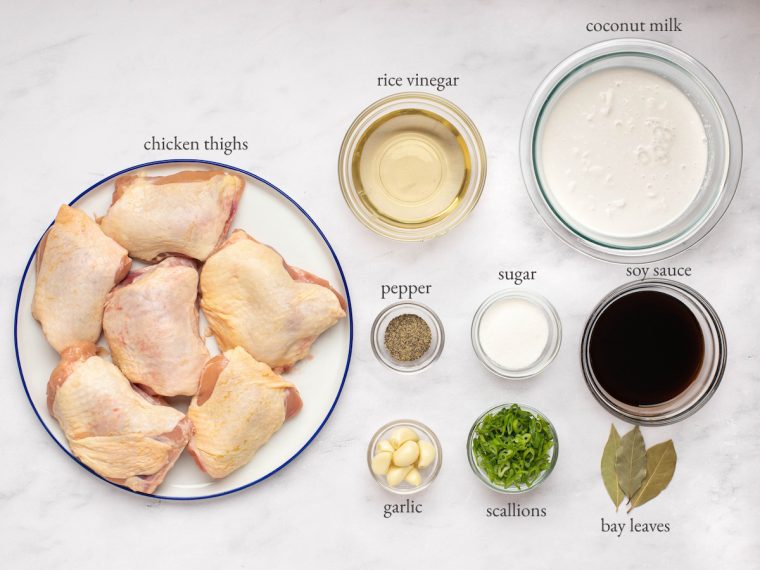
- Chicken thighs: Bone-in, skin-on thighs work well here due to their ability to stay juicy and flavorful, especially when cooked using the slow simmering method. Trim any excess fat or skin from the chicken thighs using kitchen shears (which is much easier than using a knife). If you like drumsticks, they’d work nicely too. If you prefer chicken breasts, go for bone-in, skin-on to keep them moist—boneless, skinless breasts will dry out with this method.
- Soy sauce: Acts as the salty base of the adobo marinade, contributing depth and umami to the dish.
- Coconut milk: Adds creaminess and a subtle sweetness, balancing the savory and acidic components of the marinade.
- Rice or cider vinegar: Introduces acidity to the dish, tenderizing the chicken and adding a bright contrast to the richness of the coconut milk and soy sauce.
- Garlic: A generous amount of garlic cloves infuse the dish with a pungent aroma and flavor, a key component in the depth of adobo’s taste profile.
- Bay leaves: Add a distinctive fragrance and herbal note.
- Scallions: Also known as green onions or spring onions, scallions provide a mild, slightly sweet onion flavor that enhances the dish without overwhelming the other flavors.
- Jump to the printable recipe for precise measurements
Step-by-Step Instructions
Step 1: Marinate. Combine the chicken and soy sauce in a bowl and marinate for for about an hour.

Step 2: Brown the chicken. In a skillet over medium heat, sear the chicken skin-side down for about 10 minutes until crisp and deeply browned. (Don’t move the chicken too soon—letting it sit undisturbed ensures a deeper sear and prevents tearing the skin. If the chicken sticks to the pan, it likely needs more time before flipping.) Set aside.
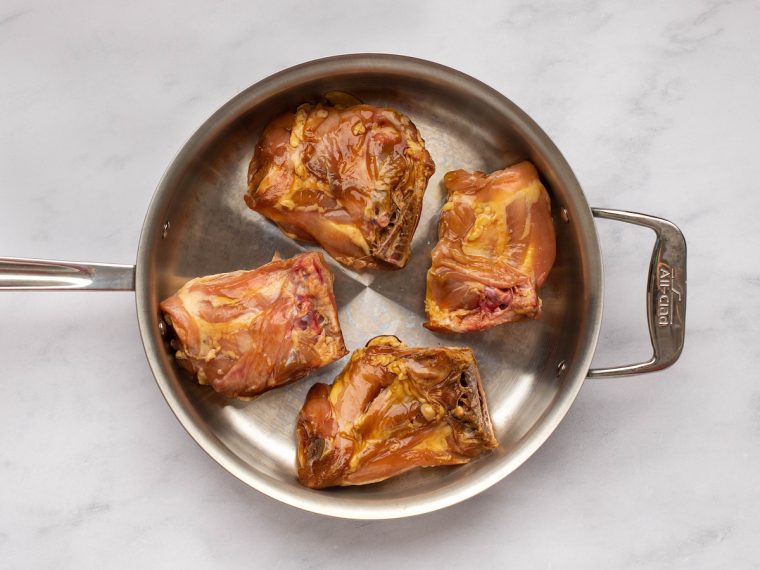
Step 3: Make the sauce. In a medium bowl, whisk together the coconut milk, vinegar, sugar, and pepper into the soy sauce.

Step 4: Simmer the chicken in the sauce. Discard the fat from the pan, wipe it clean, and pour in the sauce. Add the garlic and bay leaves, then return the chicken to the pan skin-side up. Bring to a boil, then reduce the heat and simmer uncovered for about 35 minutes, until the chicken is cooked through. Keeping the skin above the liquid ensures it stays crisp rather than becoming soggy.
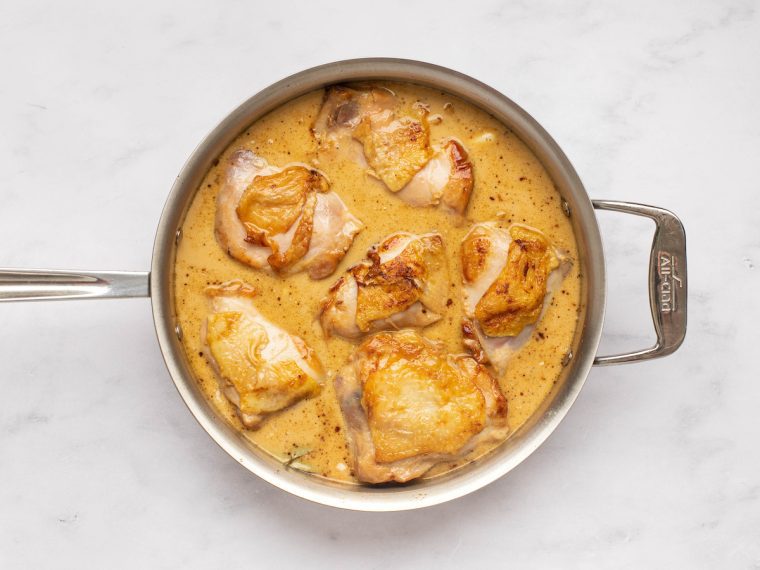
Step 5: Finish the sauce and serve. Transfer the chicken to a platter and simmer the sauce until thickened. Return the chicken to the sauce or pour it over the chicken on a platter. Scatter with scallions and serve. Alternatively, make the chicken a day or two ahead (it tastes even better as the flavors deepen and meld together). Leftovers can be frozen for up to 3 months.

Video Tutorial
More Chicken Dishes You may like
Filipino Chicken Adobo

Spice dinnertime up with this flavor-packed chicken adobo recipe—a Filipino favorite.
Ingredients
- 3½ pounds bone-in chicken thighs (6-8), trimmed (see substitutions note below)
- ½ cup soy sauce (use gluten-free if needed)
- 1 (13.5 oz) can unsweetened coconut milk
- ½ cup rice or cider vinegar
- 2 tablespoons sugar
- 1¼ teaspoons freshly ground black pepper
- 8 garlic cloves, peeled
- 3 bay leaves
- 3 scallions, green parts only, thinly sliced
- White rice, for serving
Instructions
- Toss the chicken with the soy sauce in a large, shallow bowl. Refrigerate for 1 hour.
- Remove the chicken from the soy sauce, allowing the excess to drip back into the bowl. Transfer the chicken, skin side down, to a cold 12-inch nonstick skillet. Set the soy sauce aside.
- Place the skillet over medium-high heat and cook until the skin is crisp and dark golden, 8-10 minutes. While the chicken is browning, whisk the coconut milk, vinegar, sugar and pepper into the soy sauce.
- Transfer the chicken to a plate and discard the fat in the skillet. Wipe the pan clean with a paper towel. Pour the soy sauce-coconut milk mixture into the pan; add the garlic and bay leaves. Return the chicken to the skillet, skin side up, and bring to a gentle boil. Reduce the heat to low and simmer, uncovered, for about 35 minutes, or until the chicken registers 175 degrees. Transfer the chicken to a platter and keep warm by tenting loosely with aluminum foil.
- Fish out the bay leaves and skim any noticeable fat off the surface of the sauce. Return the skillet to medium-high heat and cook until the sauce is slightly thickened, about 5 minutes. Taste and adjust seasoning if necessary (if it is too assertive, add a few tablespoons of water and/or a bit more sugar). Pour the sauce over the chicken and sprinkle with the scallions. Serve with rice. (Note: if you'd like the skin to be extra crispy, place the chicken breasts on a baking sheet and broil for a few minutes before serving.)
- Note: Drumsticks, similar to chicken thighs in terms of flavor and juiciness, are a great alternative. If you'd like to use white meat, use bone-in, skin-on chicken breasts. If you'd like to use boneless, skinless chicken thighs, skip the first cooking step of searing the skin, and reduce the simmering time to about 20 minutes.
- Make-Ahead Instructions: This dish is wonderful prepared ahead of time. After reheating, transfer the chicken to a foil-lined baking sheet, skin side up, and quickly crisp the skin under the broiler.
Pair with
Nutrition Information
Powered by ![]()
- Per serving (6 servings)
- Calories: 752 g
- Fat: 58 g
- Saturated fat: 24 g
- Carbohydrates: 10 g
- Sugar: 5 g
- Fiber: 1 g
- Protein: 47 g
- Sodium: 1392 mg
- Cholesterol: 259 mg
This website is written and produced for informational purposes only. I am not a certified nutritionist and the nutritional data on this site has not been evaluated or approved by a nutritionist or the Food and Drug Administration. Nutritional information is offered as a courtesy and should not be construed as a guarantee. The data is calculated through an online nutritional calculator, Edamam.com. Although I do my best to provide accurate nutritional information, these figures should be considered estimates only. Varying factors such as product types or brands purchased, natural fluctuations in fresh produce, and the way ingredients are processed change the effective nutritional information in any given recipe. Furthermore, different online calculators provide different results depending on their own nutrition fact sources and algorithms. To obtain the most accurate nutritional information in a given recipe, you should calculate the nutritional information with the actual ingredients used in your recipe, using your preferred nutrition calculator.
Gluten-Free Adaptable Note
To the best of my knowledge, all of the ingredients used in this recipe are gluten-free or widely available in gluten-free versions. There is hidden gluten in many foods; if you're following a gluten-free diet or cooking for someone with gluten allergies, always read the labels of your ingredients to verify that they are gluten-free.
See more recipes:
Comments
Add a Comment Cancel reply
This site uses Akismet to reduce spam. Learn how your comment data is processed.


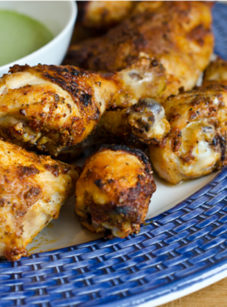

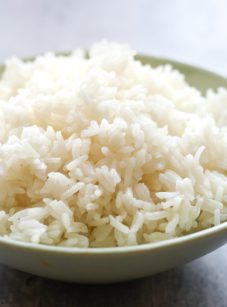

Question: I noticed that this recipe does not include usual sauté onion in adobo, does that have something to do with using coconut milk? Or just an optional ingredient? Thanks
Hi Dawn, I chose to go with a healthy amount of garlic instead of onion. Hope you enjoy the chicken if you make it!
Hi Jenn, planning to make this for upcoming family dinner for 12. Do you think boneless skinless thighs (5lbs?) would work instead of the bone in? Should I double or triple sauce recipe and can I make them a day ahead and reheat next day?
FYI served your stacked enchiladas at last family dinner to rave reviews! There was a struggle over leftovers, my Grandson won 😉 Thank you for wonderful recipes everytime
Glad the stacked enchiladas were a hit! Yes, boneless, skinless chicken thighs will work; just skip the first step of searing the skin and reduce the simmering time to about 20 minutes. I think you can get away with just doubling the sauce and this dish reheats wonderfully. Hope everyone enjoys!
Once upon a chef is one of my go to sites for family meals. I have to be honest this is one of the only recipes that I thought was a big miss. I did use chicken drumsticks instead of thighs so perhaps that is why. Although I hate to leave anything negative since this is such a go to site, had to since it stinks to have a family dinner that doesn’t work out and I’d try another one of her great recipes.
Followed this to a T pretty much, although used a bit less sugar. It was excellent. I don’t see how anyone can find this too vinegary, it was really well balanced. I’m Filipino but born in Canada and only recently have been learning to cook some Filipino dishes. Authentic adobo like my parents cooked me is much more vinegary than this recipe I think. One thing I added was full peppercorns because that’s a classic feature of adobo. I love crunching down on one, it’s a fun surprise and burst of flavour 🙂 This is a great take on a classic dish.
I’ve been making Filipino adobo for years; never really quite finding the perfect recipe. That has all changed. The addition of the coconut milk is a phenomenal way to balance the vinegary-salty delicious adobo sauce. I used unsweetened coconut milk and ended up adding slightly more sugar at the end because of this. What a gorgeous, rich, deeply flavorful dish. I would also note, it is nice to do 1/4 cider vinegar and 1/4 rice vinegar for even more depth of flavor. Just because it might not be 100% authentic doesn’t mean it’s not a far improvement to the taste buds! Thank you for posting this dish – you really have the best ideas!
Well, I’m sure becoming a fan. So far, every recipe on your site that I’ve tried, we have loved. Tonight’s was no exception. It was so nice to have something a little different than my usual chicken thigh preparation. My husband, who is not the most adventuresome eater really liked it. We’ll definitely be having it again.